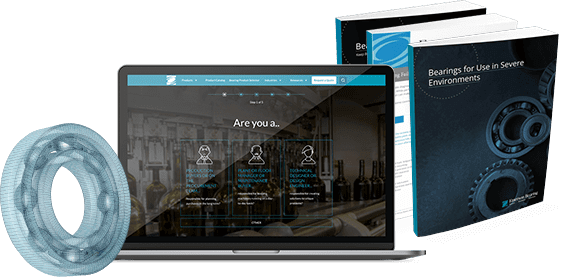Bearing Failure Analysis: Types, Causes, and Prevention
Precision bearings are durable industrial components responsible for carrying loads in myriad applications. Roller bearings, a bearing type utilizing rollers or balls as rolling elements, are so reliable that over 99% of them last for their full projected service life, even under the harshest conditions.
However, their life span is dependent upon load, speed, application, and operating conditions. While only a small fraction of bearings fail prematurely, this failure can result from numerous factors like corrosion, rust, creeping, flaking, pitting, skewing, or spalling. Each of these problems stems from small, interrelated, and — most importantly —preventable causes.
Bearing failure analysis encompasses the data collection and analysis that goes into identifying the specific cause of bearing failure. Performing such an analysis can prevent full system breakdowns and lead to innovation in new bearing product designs.
For over half a century, Emerson Bearing has provided clients in diverse industries around the world with precision-engineered, high-quality bearings and accessories. We pride ourselves on helping customers find the ideal bearing for their unique needs, but our team can also assist you in determining the cause of bearings’ premature failure when it occurs. Read on to learn more about the importance of bearing failure analysis, how they’re completed, common bearing failure types, and what the Emerson Bearing team can do to help.
When Is Bearing Failure Analysis Needed?
Emerson Bearing conducts a bearing failure analysis when customers submit failed bearings to our team. We’ll also do a bearing analysis when developing or improving bearing designs and applications. This process involves determining the main cause of the failure and how to make the necessary repairs to prevent future bearing failure, saving the time and money that operations might otherwise lose due to downtime.
According to machine designers, bearings should last for a certain number of hours based on the type of operation before experiencing normal failure. To prevent bearing failure and unscheduled downtime, it’s important to replace bearings before their expected normal life.
How to Perform a Bearing Failure Analysis
A bearing failure analysis follows these steps to gather data and identify the failure’s specific cause:
- Professionals conduct a visual examination of the bearing and assess its condition when disassembling it.
- A laboratory analysis examines oil samples and other types of particles embedded in the components.
- All relevant operating data — including bearing temperatures, oil outlet temperatures, vibration levels, and pressure levels — are evaluated.
- Experts identify any prior incidents that could have contributed to the bearing failure, along with histories of failure and recent operational changes.
- The process completes with a final analysis of the sequence of events causing the failure.
Types of Bearing Failures
Bearing failure can occur due to numerous reasons. Below, we’ll detail common causes of bearing failure.
1. Insufficient Lubrication
One common cause is a lack of lubrication, which leads to scraping between the rolling elements instead of a smooth gliding motion. This scraping generates heat that accelerates bearing failure.
2. Excessive Lubrication
Conversely, too much lubrication might allow for gliding but result in grease churning, which also produces heat and increased energy losses. As a result, internal components such as the raceway and ball bearings experience wear.
The service life of the lubricant should be matched to the service life of the bearing. For example, if a bearing has an expected life of 2,000 hours using standard grease, you can extend the life of the bearing by 10% to 20% if you use a higher-grade lubricant.
3. Contaminated Lubrication Causing Housing Failure
Fluid may leak into bearings if their mechanical seals experience failure. These fluids could include water and other substances that can render the bearings ineffective or unable to perform properly.
4. Internal Clearance
Bearings may also have too much or too little internal clearance that results in friction and high temperatures, eventually causing failure. Too much clearance will cause excess metal-on-metal contact and bearing overload. Too little clearance will cause shafts to wobble and prevent bearings from working as intended.
5. Overloading
Overloading may cause failure and has several potential causes, such as fluids with an unexpectedly high viscosity, pumps operating away from their curves, and the presence of solids in the pumped fluid.
6. High Temperatures
Many of the same issues that cause overloading can cause overheating of parts, to the point where the units expel lubricants and result in failure. This risk makes it important to perform temperature checks when commissioning equipment.
7. Misalignment
Components not designed to handle substantial stress may absorb uneven radial loads resulting from misalignment, leading to bearing failure modes.
8. Operational Stress and Bearing Selection
While roller bearings are typically a dependable option, modifications to their overall application can alter their performance and effectiveness. For example, if an application’s load decreases to the point it’s too low or increases so that it’s excessively high, roller bearings may skid or experience fatigue. In such cases, watch out for strange noises, rising temperatures, or similar indicators of impending bearing failure.
Importance of Proper Bearing Maintenance
Bearings remain one of the most important components to monitor with predictive maintenance. While these parts are inexpensive and smaller than other seemingly more important parts, their functionality is critical for maintaining operations. Bearings frequently experience wear because of their design and function, which means they demand more maintenance and care. Bearings need ample lubrication to maximize their service life and reduce the risk of breakdowns.
You can keep your bearings functioning and replace them regularly with a solid maintenance schedule in place. Generally, you should get preventative maintenance for bearings with the following frequencies:
- Once per month for electric motor applications
- Once per month for shaft bearings
- Once every two months for support bearings
- Twice per month for cylinder head bearings
Advantages & Benefits of Emerson’s Bearings
Industrial systems and equipment require bearings for daily operations, making it necessary to choose and maintain compatible bearings. The wrong bearings or bearing failure could lead to system breakdowns, downtime, reduced productivity, and lost profits.
At Emerson Bearing, we’re here to help you overcome all bearing challenges. We’ll help you find the right bearings for your operations at the right price and develop a delivery schedule that works best for you. We provide our customers with the bearings they need through our Worldwide Sourcing Network, and we offer a range of added services, including OEM part interchanges, OEM and MRO expertise, same-day shipping, and 24/7 customer support.
Prevent Bearing Failure With Emerson Bearing
For an extensive selection of high-quality bearings and bearing services, trust the experts at Emerson Bearing. Download our eBook, “Bearing Failure Analysis” to learn more about the benefits of this important practice. Contact us today for more information about our products and services.
Learn about bearings and their use.Check out our Technical Toolbox
for FREE downloads.

Technical Toolbox
View our library that includes our Nomenclature
Guide, Vendor Guides, eBooks and much more to
help with your next project! 

Bearing Failure Analysis
The accurate diagnosis of a bearing failure is imperative
to prevent repeated failures and their additional expenses.
This comprehensive guide to bearing failures outlines the
many ways bearings can and do fail. 

Industry Solutions and Bearing Resources
If you'd like to learn how bearings are being used in your
industry, check out our Industry Solutions page which has
dozens of eBooks, charts and data sheets. 
Browse our resource library!
Find custom product selectors, catalogs, CAD files,
eBooks, and more!
- Explore the library
or














